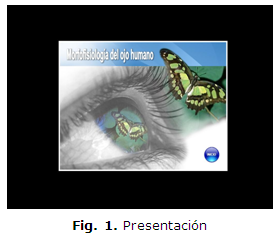Educative software: morphology and physiology of the human eye
Keywords:
Software, morfofisiología, Ophthalmology.Abstract
Introduction: the accelerated technologic development has given origin to the new technologies of information and communication, with implications in the teaching of Medicine in Cuba, adjusting to the graduate's insertion into the community, to carried out health actions and provide high quality medical services, in specialties like ophthalmology.Objective: to design a educative software for teaching and learning the macro-functional characteristics of the vision organ, in view of the performance way of the first-year Medicine students of Eastern Havana School Medical Sciences.
Material and method: pedagogical study of the promotion results of the subject Morphology and Physiology III. Several methods were used such as theoretical, empirical, dialectic-materialistic, and statistical ones. The target group and the sample were composed of professors of Informatics, specialists in Comprehensive Medicine and in Basic Sciences.
Results: it was necessary to perfect the teaching aids and achieve a scientific conception of the world using the advances of the new technologies. The software consists of several modules, which present fundamental morphologic and physiologic contents and more frequent eye disease and of greater importance for the general training of medical specialists.
Conclusions: this software constitutes a new contribution to the teaching-learning process about the vision organ. It tributes to the performance way of the coming graduate, by means of values formation, contents interactivity, back-feeding, evaluation, and the development of skills like independent work and self-training using the modern teaching aids.
Downloads
References
1. Mejías Sánchez Y, Duany Machado OJ, Toledo Fernández Am. Cuba y la cooperación solidaria en la formación de médicos del mundo. Rev. Educación Médica Superior. 2010; 24(1):4-20.
2. Marquès P. Posibilidades de las TIC en educación especial. [Internet]. 2011 [Consultado10.02.2012]. Disponible en: http://www.peremarques.pangea.org
3. Rodríguez Cortés V, del Pino Sánchez E. Proceso docente educativo: una visión para el profesor de la asignatura de Morfofisiología Humana (I). Educ Med Super. 2009; 23(3):13-8.
4. Fernández Pérez J, Reyes Reyes S, Blasco Carratalas A. Farmacología. CápII. En: Alañón Fernández FJ, Fernández Pérez J, Ferreiro López S. Oftalmología en atención Primaria. Madrid: Formación Alcalá; 2001: 47.
5. Vidal M, Gómez F, Ruiz M. Software educativos. Educ Med Super. [revista en la Internet]. 2010 Mar [citado 18 Abr 2010 ];24(1):97-110. Disponible en: http://scielo.sld.cu/scielo.php?script=sci_arttextpid=S0864-21412010000100012lng=es
6. Vidal M, Nolla N, Diego F. Plataformas didácticas como tecnología educativa. Educ Med Super[revista en la Internet]. 2009 [citado 11 Nov 2009]; 23(3) Disponible en: http://bvs.sld.cu/revistas/ems/vol23_3_09/ems13309.htm
7. Clark RE. Five Common but Questionable Principles of Multimedia Learning. En: Clark. The Cambridge Handbook of Multimedia Learning. Cambridge: Cambridge University Press; 2009: 90-4.
8. O'Farrill E. El Centro de Cibernética Aplicada a la Medicina, estrategia: 1985-1995. Cuba. Revista Cubana de Informática Medica. [Internet]. 2007 [citado 2008 May 15]; (1): [Aprox. 10 p.] Disponible en: http://www.rcim.sld.cu/revista_12/articulos_htm/estrategiacecamdos.htm
9. Lombillo Rivero I. La utilización de los medios de enseñanza y las tecnologías de la información y la comunicación en la nueva universidad universalizada. ¿Una relación dinámica? Revista Pedagogía Universitaria [Internet] 2006 [Citado 2009 Mar 02]; 11(3): [Aprox. 20 p.] Disponible en: http://cvi.mes.edu.cu/peduniv/index.php/peduniv/article/view/375/366
10. Area M. Introducción a la tecnología educativa. Universidad de La Laguna. [Internet]. 2009 [Consultado15.03.2012]. Disponible en: http://webpages.ull.es/users/manarea/ebookte.pdf
11. Rodríguez Morell JL. Universalización, internacionalización y educación multicultural: hacia un nuevo paradigma de la Universidad Cubana contemporánea. Revista Cubana de Educación Superior. 2006; 26(2): 113-9.
12. Wong Orfila T, Gutiérrez Maydata A, Díaz Velis Martínez E. Alternativas metodológicas para el establecimiento de la vinculación básico-clínica de la anatomía en la carrera de Medicina. Educ Med Super [Internet]. 2007 Jun [citado 2014 Mar 01]; 21(2): [Aprox. 9 p.] Disponible en: http://scielo.sld.cu/scielo.php?script=sci_arttextpid=S0864-21412007000200005lng=es
13. Almeida Campos S. La universalización de las Ciencias Médicas. Un nuevo reto a la enseñanza médica cubana. Memorias de la Convención Internacional [CD-ROM]. La Habana: Universidad; 2006.

Published
How to Cite
Issue
Section
License
Authors who have publications with this journal agree to the following terms: Authors will retain their copyrights and grant the journal the right of first publication of their work, which will be publication of their work, which will be simultaneously subject to the Creative Commons Attribution License (CC-BY-NC 4.0) that allows third parties to share the work as long as its author and first publication in this journal are indicated.
Authors may adopt other non-exclusive license agreements for distribution of the published version of the work (e.g.: deposit it in an institutional telematic archive or publish it in a volume). Likewise, and according to the recommendations of the Medical Sciences Editorial (ECIMED), authors must declare in each article their contribution according to the CRediT taxonomy (contributor roles). This taxonomy includes 14 roles, which can be used to represent the tasks typically performed by contributors in scientific academic production. It should be consulted in monograph) whenever initial publication in this journal is indicated. Authors are allowed and encouraged to disseminate their work through the Internet (e.g., in institutional telematic archives or on their web page) before and during the submission process, which may produce interesting exchanges and increase citations of the published work. (See The effect of open access). https://casrai.org/credit/


